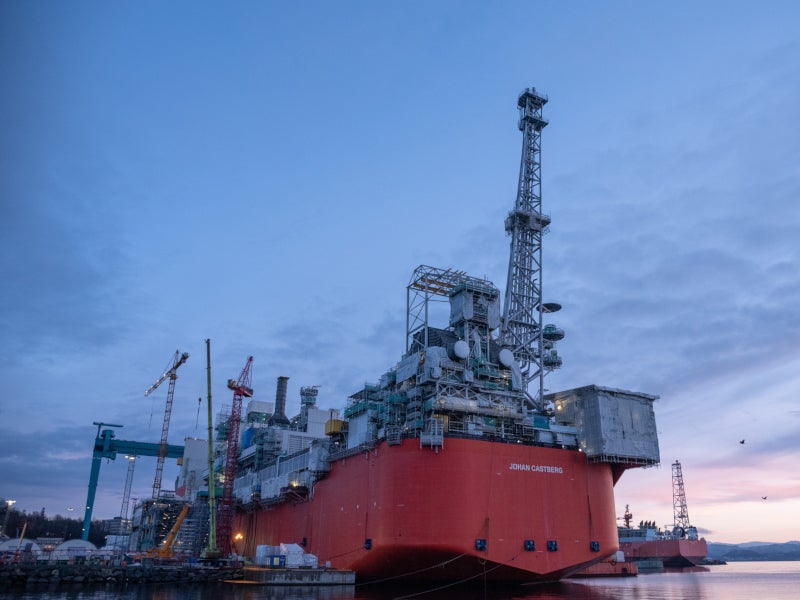The Johan Castberg project comprises three oil fields, namely Johan Castberg (formerly Skrugard), Havis, and Drivis, located in production licence PL 532, approximately 100km north-west of the Snøhvit-field in the Barents Sea, offshore Norway.
Ownership of production licence PL532 is held by Equinor (50%), Vår Energi (30%) and Petoro (20%).
The oil fields are located at water depths of approximately 360m to 390m. The reservoirs extend to depths of 1,900m and are expected to hold 400 to 650 million barrels of proven oil reserves.
The Johan Castberg project is operated by Equinor (formerly Statoil). Equinor submitted the project’s plan for development and operation (PDO) in December 2017, while the project received approval from the Norwegian Government in June 2018.
Construction of the Johan Castberg project’s topside began in November 2018. The floating production storage and operation (FPSO) vessel for the project reached Aker Solutions’ Stord yard in Norway for turret and process module installation in April 2022.
First oil from the field is expected to flow in the fourth quarter of 2024.
Estimated to cost approximately Nkr49bn ($8.01bn), the project will generate employment for approximately 4,800 people during the construction period.
The field’s production capacity is expected to be 190,000 barrels of oil equivalent per day (boepd) over an estimated operational life of 30 years.
Discovery, drilling, and development of the Johan Castberg project
Johan Castberg was discovered in April 2011 and Havis in January 2012 while Drivis was discovered in May 2014. The fields are situated in blocks 7219/9 and 7220/4,5,7. The project lies 150km north-west of Goliat and roughly 240km from Melkøya.
The fields were discovered after the 20th licensing round on the Norwegian Continental Shelf was announced in April 2009 by the Ministry of Petroleum and Energy.
Drilling of Johan Castberg was concluded in early 2011 with the completion of the drilling of the well (7220/8-1) using Transocean’s rig Polar Pioneer, which encountered hydrocarbons at approximately 1,250m below sea level.
Drilling of the Havis prospect concluded in early 2012. The last well, 7220/7-1 was drilled using Aker Solution’s rig, Aker Barents. The well was drilled to a depth of 2,200m below sea level and at a sea depth of 365m. Estimated volumes from Havis are expected to be between 200 and 300 million barrels of recoverable oil equivalent.
The appraisal of the Skrugard (now known as Johan Castberg) discovery was concluded in March 2012. Appraisal well 7220/5-1 was drilled using the Transocean Barents drilling rig to a depth of 1,740m below sea level, at a water depth of 388m. The appraisal confirmed the estimated initial volume from the Skrugard and Havis facilities in the range of 450 to 650 million barrels of recoverable oil.
Equinor is also drilling exploration wells around the Johan Castberg area to further increase the resources to make the project more robust. The company discovered the Skruis exploration, adding to Johan Castberg’s recoverable reserves in October 2018.
Snøfonn Nord and Skavl Stø are the two new discoveries in the project area that were confirmed in May and June 2022, respectively.
Development of the Norwegian oil fields
The Johan Castberg development includes the installation of an FPSO with a pipeline to shore and an onshore oil terminal at Veidnes, outside Honningsvag, in Finnmark.
The subsea system will comprise 30 wells spread over ten templates and two satellite structures, along with umbilicals, subsea trees, wellheads, and flowlines.
The 1,900t FPSO vessel will be equipped with two gas turbine generators, water, gas and chemical injection modules, flare system besides being capable of accommodating 140 workers.
A total of 18 production wells will be drilled, in addition to 12 water and gas injection wells to provide pressure support.
Transportation of the produced oil from offshore to the onshore oil storage facility will be facilitated by a pipeline measuring 280km in length.
The oil will be stored in two mountain caverns. It will be transferred to the quay through a pipeline. Crude tankers will further transport the oil from the terminal.
The field will have a supply and helicopter base in Hammerfest and an operations base in Harstad.
Contractors involved
Aker Solutions is responsible to deliver the subsea production system and the topside engineering on the Johan Castberg FPSO.
Kvaerner (now Aker Solutions) received the contract for the delivery of topside modules, in addition to hook-up and integration, in February 2018.
Singapore-based Sembcorp Marine was awarded the engineering, procurement, and construction (EPC) contract for the hull and living quarters of the FPSO.
Aker Solutions was contracted to provide the submersible wireless installer for tubing (SWIFT) solution for 18 tubing hanger installations at the field in June 2023.
Transocean was contracted to perform drilling at Johan Castberg using the Transocean Enabler semisubmersible drilling rig in March 2023.
ABB was contracted to provide digital automation and safety solutions for the project in 2018.
SBM Offshore was contracted to deliver the turret mooring system for the FPSO.
IKM Ocean Design conducted the pre-front-end engineering design (FEED) for the project.
Sevan Marine received a contract in March 2012 to carry out a concept study for utilising an FPSO for the development of the Johan Castberg field. The company was also involved in the feasibility study that was conducted for the project earlier in 2011.
Other contractors involved in the Johan Castberg project are Heerema Marine Contractors, SUEZ, Subsea 7, Siemens, PALFINGER MARINE, Baker Hughes, Multiconsult, Jotron, Kongsberg Oil & Gas Technologies, Energomontaż-Północ Gdynia, ProSep, KOSO Kent Introl, Glamox, Alcatel Submarine Networks, Ocean Installer, Vissim, Hummervoll Industribeleg, AF AeronMollier, and MRC Global.






